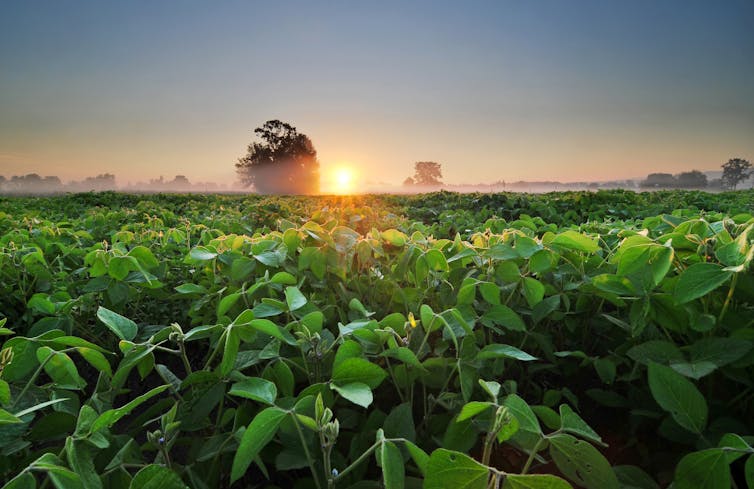How the China-US trade war could push up the cost of British chicken dinners
- Written by Theo Stanley, Postdoctoral Research Fellow in Environmental Geography, University of Southampton
Until the end of October, China had refused to purchase a single soya bean from the US’s 2025 harvest. It usually spends tens of billions of dollars on the crop, which is a key ingredient in animal feed, so the boycott hit US farmers hard – and affected food systems far beyond US and Chinese borders.
Since then, a meeting between the countries’ two presidents has meant that the soya bean trade is back on for the time being. But the stand-off[1] is yet another reminder of the vulnerability of global trade to geopolitical crises.
Shocks in supply chains often lead to rising prices, and expensive soya beans can quickly push up the cost of meat elsewhere. This happened after the price of wheat, another animal feed ingredient, spiked in 2022[2] following Russia’s full scale invasion of Ukraine[3].
Many countries are completely reliant on imported soya. In the UK, around 70% of the cost[4] of producing a chicken is what farmers feed them, and soya is a vital ingredient.
Last year the UK imported 2.4 million tonnes[5] of soya beans and “meal” (made from grounding and heating the beans after their oil has been extracted), mostly from Argentina and Brazil, two of the world’s largest exporters. China imported 105 million tonnes[6], including 27 million tonnes from the US[7].
If China switched to buying more, or even all, of its soya from South America, prices could increase for UK companies[8] whose import infrastructure is locked in to the South American supply chain. To keep chicken prices low, some supermarkets and wholesalers may start selling fresh chicken produced overseas, which can be reared to much lower welfare[9] and environmental standards than in the UK.
One of the reasons for the high demand in the UK for soya beans is that the meal used to feed chickens has an extremely high concentration of protein[10], at around 48%. Similar produce made from sunflower seeds or fava beans is about 30%.
It is this high protein content which allows modern meat (“broiler”) chickens to grow quickly and efficiently.
In the 1950s, chickens required around 4.4kg of feed per 1kg of meat produced[11]. Improvements in the sciences of genetics and nutrition mean that today that ratio can be as low as 1.3kg of feed for the same amount of meat. The most common chicken strain, known as the Ross 308, can grow to 2.5kg in just six weeks[12].
For many in the industry, these developments are a triumph of science and biotechnology. Less feed means lower costs and a smaller environmental footprint. But animal welfare experts have highlighted that these efficiency gains can come at the expense of welfare[13] and lead to increased mortality rates[14].
And there are also fears about a national protein shortage if the soya supply were to be compromised. This might be the result of drought in soya-growing regions, geopolitical tensions, trade blockades or war. As part of ongoing government-funded research[15] into the resilience of the UK food system, I have been interviewing animal feed experts, and many expressed concern that the UK does not have a domestic protein source in sufficient quantities.
Currently the UK chicken industry – and all the roast dinners, nuggets, curries and sandwiches it provides – relies on soya beans. But because they struggle to grow in the UK’s cool and wet climate, they have to be imported.
Attempts to grow a domestic alternative protein for chicken feed have struggled. Peas, beans, sunflower and rapeseed, all of which grow in the British climate, have a much lower protein content than soya beans, are harder to grow predictably, and are difficult to digest.
Distillers’ grain, the byproduct leftover from bioethanol production, could be a promising high-protein alternative[16]. But the largest bioethanol plant in the UK shut down in August 2025[17] because of changing US-UK tariff agreements, and cheap imports have now made domestic production economically non-viable.

Insect meal is promising in theory but cannot be scaled to anywhere near the same quantities as soya[18], which arrives in Liverpool from South America every week in huge amounts.
Modern supply chains have been built on systems of logistics which are incredibly efficient when things go right, but are not necessarily resilient to things going wrong. And while the “soya bean war” might not end up drastically disrupting the UK food system, it does highlight the precarious framework of international trade.
MI5 has a saying that the UK is “four meals away from anarchy”[19], suggesting any serious interruption to the country’s food supply chain would lead to mass disorder. Chicken, the county’s most popular meat, is completely dependent on overseas imports. And although global commodity supply chains have stayed generally stable throughout the 21st century, that stability can never be taken for granted.
References
- ^ stand-off (theconversation.com)
- ^ spiked in 2022 (www.bbc.com)
- ^ invasion of Ukraine (theconversation.com)
- ^ 70% of the cost (www.tescoplc.com)
- ^ 2.4 million tonnes (www.nfuonline.com)
- ^ 105 million tonnes (www.globaltimes.cn)
- ^ 27 million tonnes from the US (www.reuters.com)
- ^ prices could increase for UK companies (www.eci.ox.ac.uk)
- ^ lower welfare (www.theguardian.com)
- ^ high concentration of protein (www.food.gov.uk)
- ^ per 1kg of meat produced (www.sciencedirect.com)
- ^ can grow to 2.5kg in just six weeks (aviagen.com)
- ^ at the expense of welfare (www.frontiersin.org)
- ^ increased mortality rates (journals.plos.org)
- ^ ongoing government-funded research (www.southampton.ac.uk)
- ^ promising high-protein alternative (www.sciencedirect.com)
- ^ shut down in August 2025 (www.bbc.co.uk)
- ^ same quantities as soya (www.wwf.org.uk)
- ^ “four meals away from anarchy” (www.thetimes.com)







